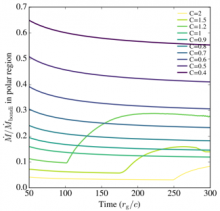
Abstract
The collapse of a massive star with low angular momentum content is commonly argued to result in the formation of a black hole without an accompanying bright transient. Our goal in this Letter is to understand the flow in and around a newly-formed black hole, involving accretion and rotation, via general relativistic hydrodynamics simulations aimed at studying the conditions under which infalling material can accrete without forming a centrifugally supported structure and, as a result, generate no effective feedback. If the feedback from the black hole is, on the other hand, significant, the collapse would be halted and we suggest that the event is likely to be followed by a bright transient. We find that feedback is only efficient if the specific angular momentum of the infalling material at the innermost stable circular orbit exceeds that of geodesic circular flow at that radius by at least ≈20%. We use the results of our simulations to constrain the maximal stellar rotation rates of the disappearing massive progenitors PHL293B-LBV and N6946-BH1, and to provide an estimate of the overall rate of disappearing massive stars. We find that about a few percent of single O-type stars with measured rotational velocities are expected to spin below the critical value before collapse and are thus predicted to vanish without a trace.